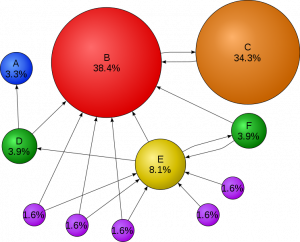Google's Search Engine Pinpoints Extinction
By Julia Whitty | Fri September 4, 2009 4:32 PM PST

Thanks to the BBC for a link to this paper describing how Google's algorithm for ranking web pages could determine what species are most critical for sustaining ecosystems.
The authors write in PLoS Computational Biology that their version of PageRank could ascertain which extinction would likely lead to ecosystem collapse.
Species are embedded in complex networks of relationships. Some more so than others. In those cases, a single extinction can cascade into the loss of many other species.Figuring this out in advance is supremely difficult. The number of links in even simple ecosystems exceeds the number of atoms in the universe. We can't sort out that kind of complexity without quantum computers.
But maybe Google can. Researchers Stefano Allesina and Mercedes Pascual reversed the definition of the PageRank algorithm that ranks a webpage as important if important pages point to it. In the conservation biology context, even humble species are important if they point to important species.
The researchers also designed a cyclical element into the foodweb system by including the detritus pool (you know, that to which all returns and that from which all arises).
Allesina and Pascual then tested their method against published foodwebs to rank species according to the damage caused if they were removed from the ecosystem. They also tested algorithms already in use in computational biology to find a solution to the same problem.The results: PageRank gave them exactly the same solution as the more complicated algorithms.In the real world, this research will likely make it easier to quickly target conservation efforts for maximum benefit.

- Do Trees Communicate? Watch This Video To Find Out.
In this real-life model of forest resilience and regeneration, Professor Suzanne Simard shows that all trees in a forest ecosystem are interconnected, with the largest, oldest, "mother trees" serving as hubs. The underground exchange of nutrients increases...
- A Vida Selvagem Está A Responder às Alterações Mais Rápido Do Que Se Pensava
Legenda: "É um bocado assustadora, esta tecnologia sem fios." Plants and animals are responding up to three times faster to climate change than previously estimated, as wildlife shifts to cooler altitudes and latitudes, researchers said on Thursday....
- Evolução - Grande Notícia Da Semana (por Falta De Tempo Fica Em Inglês)
Of microorganisms and man. First large-scale formal quantitative test confirms Darwin's theory of universal common ancestry Physis Org, May 12, 2010 More than 150 years ago, Darwin proposed the theory of universal common ancestry (UCA), linking all...
- Uma Viagem Por Toda A História Da Botânica - Exposição Order From Chaos: Linnaeus Disposes
The from which Linnaeus brought order can be seen not only as the previous and contemporary literature in which plants and animals were named and described in as many styles as there were authors but also as the explosion in new species found during...
- Alguns Animais Nasceram Selvagens E Outros Não
Scientists have Identified Genetic Regions Linked to Tameness by Denise ChenJune 24, 2009 [posted here] There are lots of differences between wild and domestic animals. Consider a wolf versus a dog, or a lion versus a cat. Aside from changes to make...
